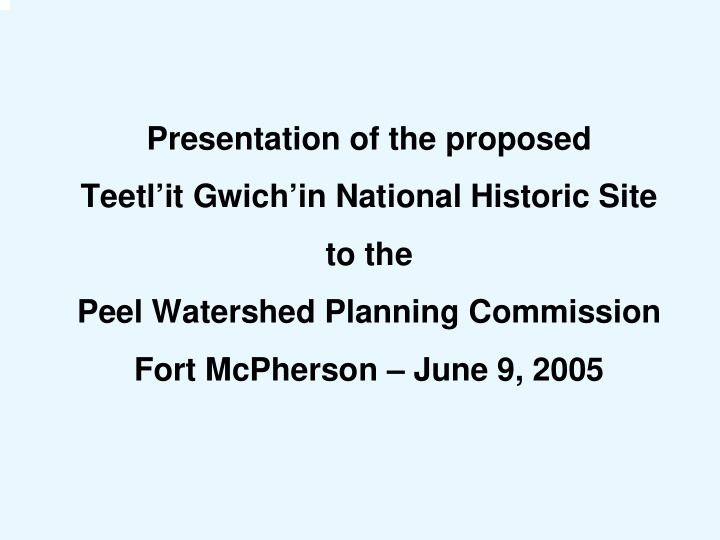



Presentation of the proposed Teetl’it Gwich’in National Historic Site to the Peel Watershed Planning Commission Fort McPherson – June 9, 2005
Teetl’it Gwich’in National Historic Site Steering Committee Members: Walter Alexie, Robert Alexie Sr., Jane Charlie, Neil Colin, Bertha Francis, Doris Itsi, William Koe, Eunice Mitchell, Sharon Snowshoe, Rachel Stewart, Mary Teya, William Teya
Overview • Present our interest in the establishment of a national historic site on Teetl’it Gwich’in lands • Based on the oral history from elders • Letters of support from landowners • National Historic Sites are a tool to increase awareness
We are the Teetl’it Gwich’in Teetl’it Gwich’in means: “in the middle (people)” or “at the head of the waters (people)” This is our home!
Gwich’in Groups at Contact Nine Gwich’in groups at contact
Proposed Teetl’it Gwich’in National Historic Site - 2 areas One section of the site begins where the Mackenzie and Peel Rivers meet and extends south to Trail River (165 km). The second part of the site is located further upriver and is a 41 km stretch of the river that includes the Peel Canyon.
Overview of Teetl’it Gwich’in History In 1826 John Franklin “discovered” and named the Peel River The Hudson’s Bay Company (HBC) crew travelled by York boat in 1839 from Fort Good Hope to the Peel River
Overview of Teetl’it Gwich’in History They paddled about 100 miles up the Peel River and met our people including Teetl’it Gwich’in leader “Painted Face’s Father” at Ok chi’ - a favourite fish camp & gathering location.
Overview of Teetl’it Gwich’in History HBC built their post at Zheh gwajat in 1840, then moved it to Chii tsal dik (Teetl’it zheh) in 1848.
Overview of Teetl’it Gwich’in History According to the Elders the fort was also moved to get a clear view of raiding Siglit, who later joined the Gwich’in in peaceful trading.
Overview of Teetl’it Gwich’in History Drawings after Murray 1848 The fort replaced the gathering places for the Teetl’it, Dagoo and Gwichya Gwich’in peoples.
Overview of Teetl’it Gwich’in History Seasonal life revolved around the land; winter camps were used for caribou hunting in the mountains.
Journey up the Peel River Aerial view of Peel Canyon
Journey up the Peel River Nagwichoo tshik - Mouth of the Peel Village
Journey up the Peel River Nagwichoo tshik - Mouth of the Peel Village
Journey up the Peel River Nagwichoo tshik - Mouth of the Peel Village
Journey up the Peel River Nagwichoo tshik - Neil Colin’s house at Mouth of the Peel Village
Journey up the Peel River Neil Colin checking his fish net at Mouth of the Peel Village
Examples of Traditional Camp & Village on the Land Natainlaii and Eight Miles Village
Example of a Sacred/Legendary Place Shildii and Deedhoo goonlii
Example of Meeting and Working with Other Cultural Groups Gwich’in and RNWMP
Example of a Burial Site Grave across from Simon vizheh (Sam’s Place)
Example of a Trail, Interaction with Other Cultural Groups, Resource Harvesting Location Walter and Robert Alexie’s camp at Trail River
Example of a Trail, Interaction with Other Cultural Groups, Resource Harvesting Location Trail River trail - traditional Teetl’it Gwich’in trail
Example of a Trail, Interaction with Other Cultural Groups, Resource Harvesting Location Teetl’it Gwich’in traditional trail
Example of a Trail, Interaction with Other Cultural Groups, Resource Harvesting Location Teetl’it Gwich’in traditional trail
Example of a Trail, Interaction with Other Cultural Groups, Resource Harvesting Location Walter and Robert Alexie’s camp at Trail River
Upper Peel River Stretch (Peel Canyon) Story of Sites Related to Moose Skin Boat Construction and Travel Moose skin boat - Fort McPherson Downstream end of Canyon
Upper Peel River Stretch (Peel Canyon) Story of Sites Related to Moose Skin Boat Construction and Travel Travelling through the Canyon
Upper Peel River Stretch (Peel Canyon) Story of Sites Related to Moose Skin Boat Construction and Travel Aerial view of the Peel Canyon looking downstream
Closing Remarks Today, most people live in Fort McPherson. We still rely on the land for food, clothing and medicine.
Replicas of 19th C. Gwich’in Caribou Skin Summer Clothing
Our Culture and Language are Closely Tied to the Land
We ask for your support in designating this site as a National Historic Site. Mahsi’ choo!
Recommend
More recommend